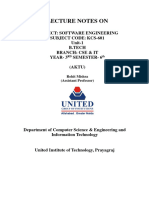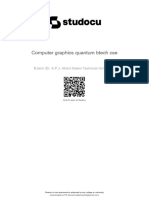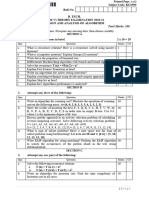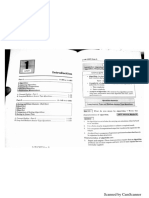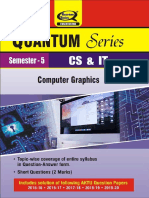AKTU Syllabus CS 3rd Yr
AKTU Syllabus CS 3rd Yr
Uploaded by
PPDC NAGAURCopyright:
Available Formats
AKTU Syllabus CS 3rd Yr
AKTU Syllabus CS 3rd Yr
Uploaded by
PPDC NAGAURCopyright
Available Formats
Share this document
Did you find this document useful?
Is this content inappropriate?
Copyright:
Available Formats
AKTU Syllabus CS 3rd Yr
AKTU Syllabus CS 3rd Yr
Uploaded by
PPDC NAGAURCopyright:
Available Formats
B.TECH.
(CSE & CS)
SIXTH SEMESTER (DETAILED SYLLABUS)
Software Engineering (KCS-601)
Course Outcome ( CO) Bloom’s Knowledge Level (KL)
At the end of course, the student will be able to
Explain various software characteristics and analyze different software Development
CO 1 K1, K2
Models.
Demonstrate the contents of a SRS and apply basic software quality assurance practices to
CO 2 K1, K2
ensure that design, development meet or exceed applicable standards.
CO 3 Compare and contrast various methods for software design K2, K3
Formulate testing strategy for software systems, employ techniques such as unit testing, Test
CO 4 K3
driven development and functional testing.
Manage software development process independently as well as in teams and make use of
CO 5 K5
Various software management tools for development, maintenance and analysis.
DETAILED SYLLABUS 3-1-0
Unit Topic Proposed
Lecture
Introduction: Introduction to Software Engineering, Software Components, Software
Characteristics, Software Crisis, Software Engineering Processes, Similarity and Differences from
I Conventional Engineering Processes, Software Quality Attributes. Software Development Life 08
Cycle (SDLC) Models: Water Fall Model, Prototype Model, Spiral Model, Evolutionary
Development Models, Iterative Enhancement Models.
Software Requirement Specifications (SRS): Requirement Engineering Process: Elicitation,
Analysis, Documentation, Review and Management of User Needs, Feasibility Study, Information
II Modelling, Data Flow Diagrams, Entity Relationship Diagrams, Decision Tables, SRS Document, 08
IEEE Standards for SRS. Software Quality Assurance (SQA): Verification and Validation, SQA
Plans, Software Quality Frameworks, ISO 9000 Models, SEI-CMM Model.
Software Design: Basic Concept of Software Design, Architectural Design, Low Level Design:
Modularization, Design Structure Charts, Pseudo Codes, Flow Charts, Coupling and Cohesion
Measures, Design Strategies: Function Oriented Design, Object Oriented Design, Top-Down and
III Bottom-Up Design. Software Measurement and Metrics: Various Size Oriented Measures: 08
Halestead’s Software Science, Function Point (FP) Based Measures, Cyclomatic Complexity
Measures: Control Flow Graphs.
Software Testing: Testing Objectives, Unit Testing, Integration Testing, Acceptance Testing,
Regression Testing, Testing for Functionality and Testing for Performance, TopDown and Bottom-
Up Testing Strategies: Test Drivers and Test Stubs, Structural Testing (White Box Testing),
IV Functional Testing (Black Box Testing), Test Data Suit Preparation, Alpha and Beta Testing of 08
Products. Static Testing Strategies: Formal Technical Reviews (Peer Reviews), Walk Through,
Code Inspection, Compliance with Design and Coding Standards.
Software Maintenance and Software Project Management: Software as an Evolutionary Entity,
Need for Maintenance, Categories of Maintenance: Preventive, Corrective and Perfective
V Maintenance, Cost of Maintenance, Software Re- Engineering, Reverse Engineering. Software 08
Configuration Management Activities, Change Control Process, Software Version Control, An
Overview of CASE Tools. Estimation of Various Parameters such as Cost, Efforts,
Curriculum & Evaluation Scheme CS & CSE (V & VI semester) 21
Schedule/Duration, Constructive Cost Models (COCOMO), Resource Allocation Models, Software
Risk Analysis and Management.
Text books:
1.RS Pressman, Software Engineering: A Practitioners Approach, McGraw Hill.
2. Pankaj Jalote, Software Engineering, Wiley
3. Rajib Mall, Fundamentals of Software Engineering, PHI Publication.
4. KK Aggarwal and Yogesh Singh, Software Engineering, New Age International Publishers.
5. Ghezzi, M. Jarayeri, D. Manodrioli, Fundamentals of Software Engineering, PHI Publication.
6. Ian Sommerville, Software Engineering, Addison Wesley.
7. Kassem Saleh, “Software Engineering”, Cengage Learning.
8. P fleeger, Software Engineering, Macmillan Publication
Curriculum & Evaluation Scheme CS & CSE (V & VI semester) 22
Web Technology (KCS-602)
Course Outcome ( CO) Bloom’s Knowledge Level (KL)
At the end of course , the student will be able to
CO 1 Explain web development Strategies and Protocols governing Web. K1, K2
CO 2 Develop Java programs for window/web-based applications. K2, K3
CO 3 Design web pages using HTML, XML, CSS and JavaScript. K2, K3
CO 4 Creation of client-server environment using socket programming K1, K2,
CO 5 Building enterprise level applications and manipulate web databases using JDBC K3, K4
CO6 Design interactive web applications using Servlets and JSP K2, K3
DETAILED SYLLABUS 3-0-0
Unit Topic Proposed
Lecture
Introduction: Introduction and Web Development Strategies, History of Web and Internet, Protocols
Governing Web, Writing Web Projects, Connecting to Internet, Introduction to Internet services and
I tools, Introduction to client-server computing. Core Java: Introduction, Operator, Data type, Variable,
Arrays, Methods & Classes, Inheritance, Package and Interface, Exception Handling, Multithread 08
programming, I/O, Java Applet, String handling, Event handling, Introduction to AWT, AWT
controls, Layout managers
Web Page Designing: HTML: List, Table, Images, Frames, forms, CSS, Document type definition,
II XML: DTD, XML schemes, Object Models, presenting and using XML, Using XML Processors: 08
DOM and SAX, Dynamic HTML
Scripting: Java script: Introduction, documents, forms, statements, functions, objects; introduction to
III AJAX, Networking : Internet Addressing, InetAddress, Factory Methods, Instance Methods, 08
TCP/IP Client Sockets, URL, URL Connection, TCP/IP Server Sockets, Datagram.
Enterprise Java Bean: Preparing a Class to be a JavaBeans, Creating a JavaBeans, JavaBeans
Properties, Types of beans, Stateful Session bean, Stateless Session bean, Entity bean
IV 08
Java Database Connectivity (JDBC): Merging Data from Multiple Tables: Joining,
Manipulating, Databases with JDBC, Prepared Statements, Transaction Processing, Stored
Procedures.
Servlets: Servlet Overview and Architecture, Interface Servlet and the Servlet Life Cycle,
Handling HTTP get Requests, Handling HTTP post Requests, Redirecting Requests to Other
V Resources, Session Tracking, Cookies, Session Tracking with Http Session 08
Java Server Pages (JSP): Introduction, Java Server Pages Overview, A First Java Server Page
Example, Implicit Objects, Scripting, Standard Actions, Directives, Custom Tag Libraries..
Text books:
1. Burdman, Jessica, “Collaborative Web Development” Addison Wesley
2. Xavier, C, “ Web Technology and Design” , New Age International
3. Ivan Bayross,” HTML, DHTML, Java Script, Perl & CGI”, BPB Publication
4. Bhave, “Programming with Java”, Pearson Education
5. Herbert Schieldt, “The Complete Reference:Java”, McGraw Hill.
6. Hans Bergsten, “Java Server Pages”, SPD O’Reilly
7. Margaret Levine Young, “The Complete Reference Internet”, McGraw Hill.
8. Naughton, Schildt, “The Complete Reference JAVA2”, McGraw Hill.
9. Balagurusamy E, “Programming in JAVA”, McGraw Hill.
Curriculum & Evaluation Scheme CS & CSE (V & VI semester) 23
Computer Networks(KCS- 603)
Course Outcome ( CO) Bloom’s Knowledge Level (KL)
At the end of course , the student will be able to
Explain basic concepts, OSI reference model, services and role of each layer of OSI model and
CO1 K1,K2
TCP/IP, networks devices and transmission media, Analog and digital data transmission
CO2 Apply channel allocation, framing, error and flow control techniques. K3
Describe the functions of Network Layer i.e. Logical addressing, subnetting & Routing
CO3 K2,K3
Mechanism.
Explain the different Transport Layer function i.e. Port addressing, Connection Management,
CO4 K2,K3
Error control and Flow control mechanism.
CO5 Explain the functions offered by session and presentation layer and their Implementation. K2,K3
Explain the different protocols used at application layer i.e. HTTP, SNMP, SMTP, FTP,
CO6 K2
TELNET and VPN.
DETAILED SYLLABUS 3-0-0
Unit Topic Proposed
Lecture
Introductory Concepts: Goals and applications of networks, Categories of networks,
Organization of the Internet, ISP, Network structure and architecture (layering principles, services,
protocols and standards), The OSI reference model, TCP/IP protocol suite, Network devices and
I components.
08
Physical Layer:
Network topology design, Types of connections, Transmission media, Signal transmission and
encoding, Network performance and transmission impairments, Switching techniques and
multiplexing.
Link layer: Framing, Error Detection and Correction, Flow control (Elementary Data Link
II Protocols, Sliding Window protocols).
08
Medium Access Control and Local Area Networks: Channel allocation, Multiple access protocols,
LAN standards, Link layer switches & bridges (learning bridge and spanning tree algorithms).
Network Layer: Point-to-point networks, Logical addressing, Basic internetworking (IP, CIDR,
III 08
ARP, RARP, DHCP, ICMP), Routing, forwarding and delivery, Static and dynamic routing,
Routing algorithms and protocols, Congestion control algorithms, IPv6.
Transport Layer: Process-to-process delivery, Transport layer protocols (UDP and TCP),
IV 08
Multiplexing, Connection management, Flow control and retransmission, Window management,
TCP Congestion control, Quality of service.
Application Layer: Domain Name System, World Wide Web and Hyper Text Transfer Protocol,
V 08
Electronic mail, File Transfer Protocol, Remote login, Network management, Data compression,
Cryptography – basic concepts.
Text books and References:
1. Behrouz Forouzan, “Data Communication and Networking”, McGraw Hill
2. Andrew Tanenbaum “Computer Networks”, Prentice Hall.
3. William Stallings, “Data and Computer Communication”, Pearson.
4. Kurose and Ross, “Computer Networking- A Top-Down Approach”, Pearson.
5. Peterson and Davie, “Computer Networks: A Systems Approach”, Morgan Kaufmann
6. W. A. Shay, “Understanding Communications and Networks”, Cengage Learning.
7. D. Comer, “Computer Networks and Internets”, Pearson.
8. Behrouz Forouzan, “TCP/IP Protocol Suite”, McGraw Hill.
Curriculum & Evaluation Scheme CS & CSE (V & VI semester) 24
You might also like
- Mathematics 4 Quantum More at QuantumSupplyDocument82 pagesMathematics 4 Quantum More at QuantumSupplyaniket menon100% (2)
- Understanding The Human Being Comprehensively PDFDocument107 pagesUnderstanding The Human Being Comprehensively PDFShivam Sharma75% (8)
- Unit 1 To 5 DSTL Notes AktuDocument133 pagesUnit 1 To 5 DSTL Notes AktuAkshat Kumar100% (6)
- Software Engineering QuantumDocument85 pagesSoftware Engineering QuantumRohit Negi50% (2)
- CN QuantumDocument188 pagesCN QuantumPriyansh Gupta75% (4)
- Mobile Computing Quantum (Motivationbank - In)Document97 pagesMobile Computing Quantum (Motivationbank - In)Prince Gupta0% (1)
- TAFL QuantumDocument78 pagesTAFL QuantumArpit SharmaNo ratings yet
- SE (KCS-601) Unit-1 NotesDocument16 pagesSE (KCS-601) Unit-1 Notesशून्य अद्वैतNo ratings yet
- Design and Analysis of Algorithm QuantumDocument359 pagesDesign and Analysis of Algorithm QuantumURFIYA SHARMEEN100% (14)
- Universal Human Values QuantumDocument107 pagesUniversal Human Values QuantumVinamra Purwar50% (2)
- Theory of Automata and Formal LanguagesDocument79 pagesTheory of Automata and Formal LanguagesAnushka Gupta0% (1)
- Data Analytics QuantumDocument142 pagesData Analytics QuantumSakshi Chauhan75% (4)
- AKTU Syllabus CS 3rd YrDocument2 pagesAKTU Syllabus CS 3rd YrPPDC NAGAURNo ratings yet
- Operating System Quantum Book For Aktu StudentsDocument96 pagesOperating System Quantum Book For Aktu StudentsHoney Tyagi100% (5)
- Object Oriented System Design QuantumDocument253 pagesObject Oriented System Design Quantumhayat70% (10)
- Soft Computing QuantumDocument84 pagesSoft Computing QuantumBilal Malik80% (5)
- AI QuantumDocument58 pagesAI QuantumCHANDRESH GANGWAR0% (1)
- Web TechnologyDocument340 pagesWeb TechnologyLavkush Tyagi100% (2)
- Quantum Web Technology Kcs 602Document338 pagesQuantum Web Technology Kcs 602Khushi PachauriNo ratings yet
- Protocols Governing WebDocument5 pagesProtocols Governing WebRicha Tekriwal100% (1)
- Unit 1 OOSD NotesDocument18 pagesUnit 1 OOSD NotesAkshat Kumar75% (4)
- Cryptography and Network Security Quantum PDFDocument44 pagesCryptography and Network Security Quantum PDFmobin98017No ratings yet
- Engineering Mathematics 1 QuantumDocument81 pagesEngineering Mathematics 1 QuantumSaurabh JaiswalNo ratings yet
- Database Management Quantum SebDocument284 pagesDatabase Management Quantum SebShivanshu Verma50% (4)
- DSTL QuantumDocument134 pagesDSTL QuantumVipin MauryaNo ratings yet
- Math IV Quantum (Aktu)Document147 pagesMath IV Quantum (Aktu)Mahskas RamotNo ratings yet
- Koe-064 Object Oriented ProgrammingDocument2 pagesKoe-064 Object Oriented Programmingsaksham agarwal0% (1)
- Assignment 2Document5 pagesAssignment 2Vasu pratap SinghNo ratings yet
- ai-previous-year-question-paper-aktuDocument11 pagesai-previous-year-question-paper-aktuSamridhi ShreeNo ratings yet
- Quantum Design and Analysis of Algorithms Full PDFDocument196 pagesQuantum Design and Analysis of Algorithms Full PDFmantasha18110No ratings yet
- Data Warehouse and Data Mining QuantumDocument69 pagesData Warehouse and Data Mining QuantumPPDC NAGAURNo ratings yet
- Computer Graphics QuantumDocument74 pagesComputer Graphics Quantumpddwivedi45No ratings yet
- Data Compression QuantumDocument82 pagesData Compression QuantumNeetish Singh100% (1)
- Notes Unit-4 Oosd by SKKDocument32 pagesNotes Unit-4 Oosd by SKKBruce WayneNo ratings yet
- Unit-3 Notes OosdDocument20 pagesUnit-3 Notes Oosdyou • were • trolled0% (1)
- Operating System QuantumDocument85 pagesOperating System QuantumVarnika TomarNo ratings yet
- Big Data QuantumDocument78 pagesBig Data Quantummrkumar9838100% (1)
- Technical Communication QuantumDocument247 pagesTechnical Communication QuantumJJ Jain75% (4)
- Combined Previous Year DAA AKTU Questions PapersDocument27 pagesCombined Previous Year DAA AKTU Questions PapersAditya DangwalNo ratings yet
- DAA Quantum PDFDocument111 pagesDAA Quantum PDFaesthetic nick62% (26)
- IT8075-UNIT-5-Best-methods-of-staff-selection-Motivation SPMDocument35 pagesIT8075-UNIT-5-Best-methods-of-staff-selection-Motivation SPMCSE 2nd year 4038No ratings yet
- Daa Notes Complete AktuDocument203 pagesDaa Notes Complete Aktushrinkhal03100% (1)
- MLT Quantum Aktu PDFDocument160 pagesMLT Quantum Aktu PDFlambhaaniket833% (3)
- Computer Graphics Quantum-1Document246 pagesComputer Graphics Quantum-1youtenger tubeNo ratings yet
- Compiler Design Quantum For AKTUDocument78 pagesCompiler Design Quantum For AKTUArchit67% (9)
- KCS-652-WT LAB Manual-2021-22Document56 pagesKCS-652-WT LAB Manual-2021-222k22.csaiml.2211562No ratings yet
- Important Questions Unit-1: I Introduction: Algorithms, Analyzing Algorithms, Complexity of Algorithms, Growth ofDocument7 pagesImportant Questions Unit-1: I Introduction: Algorithms, Analyzing Algorithms, Complexity of Algorithms, Growth oftarun tyagiNo ratings yet
- Cloud Computing Notes B Tech AKTU by Krazy Kreation (Kulbhushan)Document4 pagesCloud Computing Notes B Tech AKTU by Krazy Kreation (Kulbhushan)Pikachu Pandey100% (1)
- AI Unit 1 Handwritten NotesDocument40 pagesAI Unit 1 Handwritten Notestonykarthi17100% (2)
- Cloud Computing All Unit More at QuantumSupplyDocument89 pagesCloud Computing All Unit More at QuantumSupplyUbaid Siddiqui100% (5)
- Software Testing AktuDocument106 pagesSoftware Testing Aktubhaviyatalwar180% (1)
- Dbms Unit 1 Acoording To AKTU SyllabusDocument22 pagesDbms Unit 1 Acoording To AKTU Syllabusmukesh.iilm144100% (1)
- DSTL Quantum PDF by Motivation BankDocument259 pagesDSTL Quantum PDF by Motivation BankAkshay Rana100% (1)
- 6th Sem SyllabusDocument15 pages6th Sem Syllabusshubhshubham616No ratings yet
- Software Engineering (KCS-601)Document2 pagesSoftware Engineering (KCS-601)Aryan SinghNo ratings yet
- Web Tech Quantum UpdatedDocument204 pagesWeb Tech Quantum Updatedanimehv5500No ratings yet
- SEDocument1 pageSEpramodmauryapkNo ratings yet
- Software Engineering QuantumDocument87 pagesSoftware Engineering Quantumpikaachuu.209No ratings yet
- software engineering syllabusDocument2 pagessoftware engineering syllabusshivamkkushwaha0No ratings yet
- Web Technology (Syllabus)Document1 pageWeb Technology (Syllabus)Arshil NoorNo ratings yet
- Tushar CVDocument5 pagesTushar CVtushark1484No ratings yet
- Lotus Completeset UKG FinalDocument136 pagesLotus Completeset UKG FinalPPDC NAGAURNo ratings yet
- Curriculum of 3 D Animation and Special EffectDocument33 pagesCurriculum of 3 D Animation and Special EffectPPDC NAGAURNo ratings yet
- Public Service Commission, WBDocument2 pagesPublic Service Commission, WBPPDC NAGAURNo ratings yet
- Project ListDocument8 pagesProject ListPPDC NAGAURNo ratings yet
- UntitledDocument193 pagesUntitledPPDC NAGAURNo ratings yet
- Indian Traditions, Cultural and Society: L: T:P: 2: 0:0 Module 1-Society State and Polity in IndiaDocument2 pagesIndian Traditions, Cultural and Society: L: T:P: 2: 0:0 Module 1-Society State and Polity in IndiaKapilNo ratings yet
- UntitledDocument75 pagesUntitledPPDC NAGAURNo ratings yet
- UntitledDocument85 pagesUntitledPPDC NAGAURNo ratings yet
- AKTU Syllabus CS 3rd YrDocument1 pageAKTU Syllabus CS 3rd YrPPDC NAGAURNo ratings yet
- AKTU Syllabus CS 3rd YrDocument1 pageAKTU Syllabus CS 3rd YrPPDC NAGAURNo ratings yet







